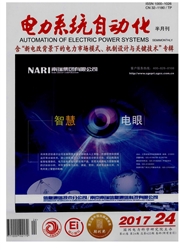

 中文摘要:
中文摘要:
实现面向低碳目标的电网规划能有效缓解电力行业的"碳锁定"效应,促进电力系统的低碳化转型。需求侧管理能够减小电源和输电容量需求,同时可以降低系统发电煤耗和输电网损,是降低电力系统碳排放的重要手段。文中分析了需求侧管理和低碳化发展对电网规划的影响,分析了典型的需求侧管理手段在约束条件中的表现形式,建立了考虑需求侧管理的低碳电网规划模型。针对模型的非线性特征设计了优化求解策略,基于分离不等式法消除模型的非线性约束,将原模型转化为混合整数线性规划模型进行求解。采用IEEE RTS79系统的算例验证了文中所述方法的有效性。算例结果表明,在电网规划中考虑需求侧管理,能够有效减少电网扩展投资并降低系统的碳排放量,提升系统整体效益。
 英文摘要:
英文摘要:
The implementation of transmission expansion planning towards low carbon development can effectively alleviate the"carbon lock"effect in the power industry and facilitate the transition to low carbon power system.The demand side management(DSM)is able to reduce the needs of power supply and transmission capacity and further bring down the generation coal consumption and transmission losses.It is therefore an important means of carbon emission reduction in power system.The paper analyzes the impact of DSM and low carbon development on transmission planning at first.By analyzing the performance of typical DSM measures in the constraints,a low carbon transmission expansion planning model is established considering DSM.Nonlinear constraints in the planning model are transformed into linear ones using inequality separation method,turning the planning model into a mixed integer linear programming model.The case study shows the effectiveness of the proposed model with IEEE RTS79 system.The results suggest that considering DSM in the transmission expansion planning can effectively reduce the transmission expansion investment and the total carbon emissions,which can improve overall benefits of the power system.
 同期刊论文项目
同期刊论文项目
 同项目期刊论文
同项目期刊论文
 期刊信息
期刊信息
